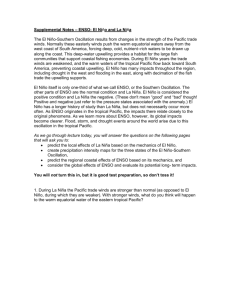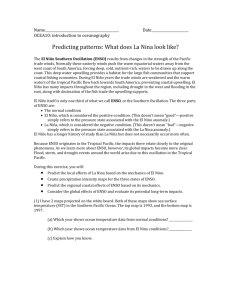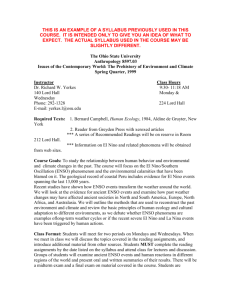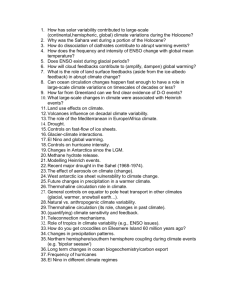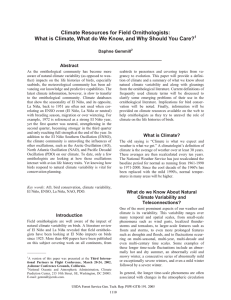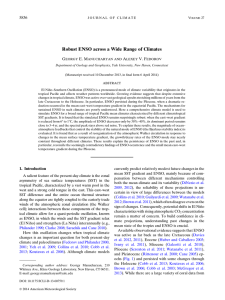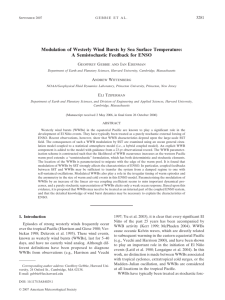El Nino - Glacier Bliss
advertisement
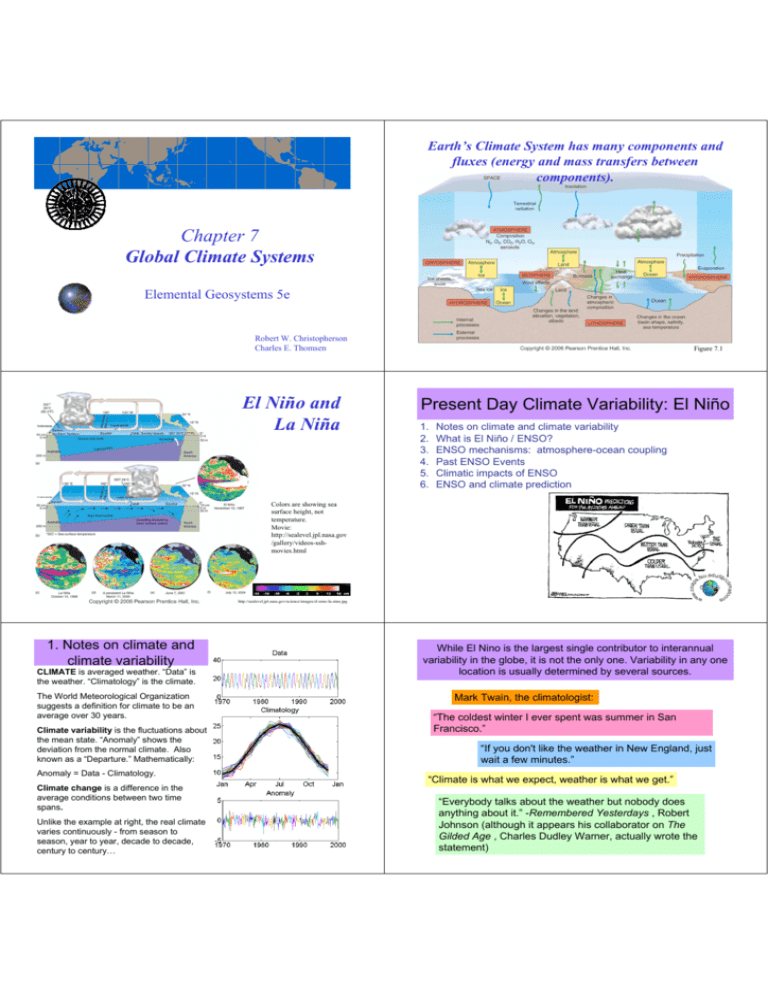
Earth’s Climate System has many components and fluxes (energy and mass transfers between components). Chapter 7 Global Climate Systems Elemental Geosystems 5e Robert W. Christopherson Charles E. Thomsen El Niño and La Niña Figure 7.1 Present Day Climate Variability: El Niño 1. 2. 3. 4. 5. 6. Notes on climate and climate variability What is El Niño / ENSO? ENSO mechanisms: atmosphere-ocean coupling Past ENSO Events Climatic impacts of ENSO ENSO and climate prediction Colors are showing sea surface height, not temperature. Movie: http://sealevel.jpl.nasa.gov /gallery/videos-sshmovies.html http://sealevel.jpl.nasa.gov/science/images/el-nino-la-nina.jpg 1. Notes on climate and climate variability CLIMATE is averaged weather. “Data” is the weather. “Climatology” is the climate. The World Meteorological Organization suggests a definition for climate to be an average over 30 years. Climate variability is the fluctuations about the mean state. “Anomaly” shows the deviation from the normal climate. Also known as a “Departure.” Mathematically: Anomaly = Data - Climatology. Climate change is a difference in the average conditions between two time spans. Unlike the example at right, the real climate varies continuously - from season to season, year to year, decade to decade, century to century… While El Nino is the largest single contributor to interannual variability in the globe, it is not the only one. Variability in any one location is usually determined by several sources. Mark Twain, the climatologist: “The coldest winter I ever spent was summer in San Francisco.” “If you don't like the weather in New England, just wait a few minutes.” “Climate is what we expect, weather is what we get.” “Everybody talks about the weather but nobody does anything about it.” -Remembered Yesterdays , Robert Johnson (although it appears his collaborator on The Gilded Age , Charles Dudley Warner, actually wrote the statement) Weather forecasting is pretty good, for a few days. http://www.stat.columbia.edu/~cook/movabletype/archives/decision_theory/ All figures that do not have a credit in today’s lecture are from: http://www.cpc.ncep.noaa.gov/products/analysis_monitoring/ensocycle/enso_cycle.shtml Heart of ENSO physics: the Bjerknes feedback Warm western SST/ Cool eastern SST Shallow thermocline in the east, deep in the west pressure gradient: low in the west, high in the east Easterly surface winds •In an El Niño, the thermocline initially deepens in the eastern equatorial Pacific •East-west contrast in sea surface temperature reduces, and surface pressure reduces in the east, increases in the west. •Anomalous winds blow from west to east because of the anomalous pressure gradient; atmospheric convection shifts from the western Pacific to the central Pacific •Anomalous winds drive additional surface ocean waters eastward that deepen the thermocline in the eastern Pacific even further… Positive (Bjerknes) feedback In a narrow sense, El Nino is a giant puddle of heated water that sloshes across the Pacific Ocean. Figure above from Jim Johnstone. Red = warm SST in these 4 recent El Niños. (NOAA via pbs.org) Temporal pattern of ENSO Darwin • Now that we’ve seen the spatial pattern of ENSO, we’ll define two indices of ENSO so that we can look at the temporal pattern: • 1) The Niño 3.4 SST index measures the SST in a region of the central equatorial Pacific • 2) The Southern Oscillation Index is the pressure difference between Tahiti, French Polynesia and Darwin, Australia. Space Shuttle pic: http://visibleearth.nasa.gov/view_rec.php?id=632 Map: http://www.fire.uni-freiburg.de/iffn/country/id/id_23.htm El Niño’s Life Cycle Initiation Peak Decay 127% 106% 140% 140% http://www.cpc.ncep.noaa.gov/products/precip/CWlink/MJO/enso.shtml and below: Jan Null, Golden Gate Weather Services Source: International Research Institute for Climate Prediction Tahiti ENSO Impact over North America The influence on N.A. is related to the Pacific and polar jet streams. El Nino allows a persistent pacific jet stream to bring storms straight to California and lower N. America. But the anomalies are highly variable! When the SOI is positive (La Niña), precip is large in the Pacific Northwest. Figure above from Jim Johnstone Below from Jan Null, Golden Gate Weather Services How do we know when El Niño occurs? Monitoring ENSO: the Tropical Atmosphere-Ocean (TAO) array Pacific SST Anomalies Jan 1998 - El Niño Red peaks: El Niño. Blue peaks: La Niña (opposite phase to El Niño) The TAO Array is a series of 69 carefully placed buoys in the tropical Pacific Ocean, started in 1985 and completed in December 1994. Each buoy has instruments that records air and sea temperature and they transmit their data to satellites daily. With all the buoys forming an array, there is a clearer picture of the changes that are a telltale sign of a coming El Niño. http://www.oc.nps.navy.mil/webmodules/ENSO/TAO.html Fall 2008: A La Niña is decaying Nov 20, 2006 at right. http://sealevel.jpl.nasa.gov/elnino/ Niño Region SST Departures (oC) Recent Evolution During the last 4-weeks, equatorial Pacific SSTs were below-average near the Date Line, and more than 0.5°C above-average between 120ºW and 80ºW. The present situation in the tropical Pacific: neutral and holding. Oceanic Niño Index (oC): Evolution since 1950 http://www.cpc.ncep.noaa.gov/products/precip/CWlink/MJO/enso.shtml#forecast The CFS ensemble mean forecast (heavy blue line below) indicates neutral conditions for a while. The most recent The most recent ONI value (June ONI value (June – August 2008) is – August 2008) is o -0.1 oC. -0.1C. El Niño neutral La Niña U. S. Seasonal Outlooks October – December 2008 Temperature Precipitation These seasonal outlooks combine long-term trends and soil moisture effects. Summary • While El Nino is the largest single contributor to interannual variability in the globe, it is not the only one. Variability in any one location is usually determined by several sources. • The Bjerknes Feedback is the mechanism that controls El Niño. pressure gradient: low in Warm western SST/ Cool eastern SST Shallow thermocline in the east, deep in the west the west, high in the east Easterly surface winds • Variability in the tropical Pacific ocean and atmosphere has global effects. The biggest one of recent times The El Niño of 1998





